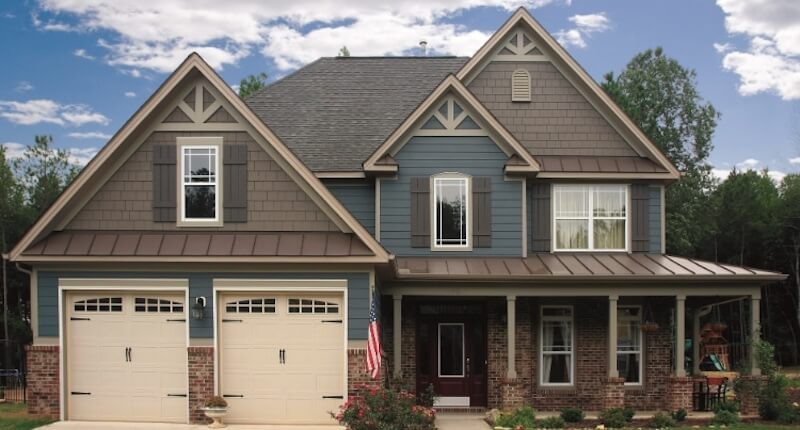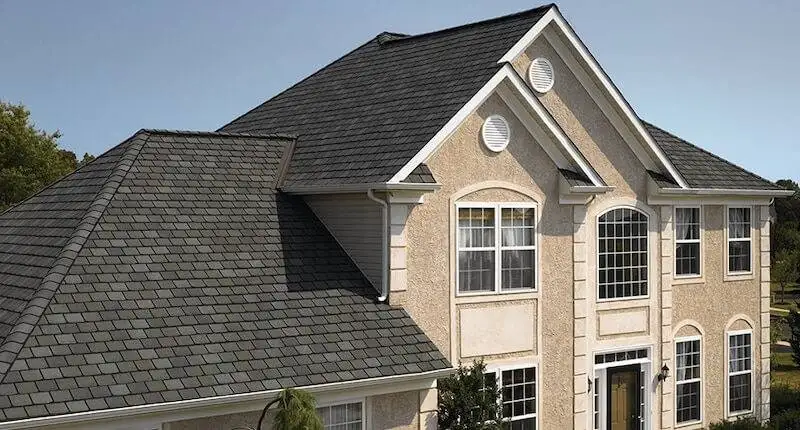Hardie Board and Batten Siding
James Hardie’s Board and Batten siding is a style of siding used on a home’s exterior to create visual interest, reinforce its durability, and increase a home’s curb appeal. Upon installation, this siding will be placed in thin vertical batten strips of molding over the panel boards. The battens are an aesthetic touch that creates vertical lines of interest on the exterior of a home. The board and batten style can be used in many different styles of homes and are often combined with other types of siding to create more visual interest than traditional vinyl siding.
Home / James Hardie / Board and Batten Siding
What Is Board and Batten Siding?
Hardie Board, a fiber cement siding product, combines the best of durability and design flexibility. It’s crafted from a mix of wood fiber, cement, sand, and water, leading to a robust material that stands the test of time. The board and batten style, which alternates wide boards with narrow strips (battens), adds a timeless, visually striking look to any home’s exterior, reminiscent of traditional architectural styles yet suitable for modern designs.
James Hardie Board and Batten
The Board and Batten style of siding is elevated with James Hardie Brand siding. James Hardie is one of North America’s leading siding providers. Tevelde and Co. is proud to be a James Hardie preferred contractor, working with the highest quality siding to bring you an appealing home exterior that’s built to last. With James Hardie siding, you can expect benefits like lifetime value, design flexibility, performance, durability, and sustainability.
- What Is Board and Batten Siding?
- James Hardie Siding
- What Kind of Style Does Board and Batten Siding Provide?
- Farmhouse Design (Rustic Charm)
- Providing a Simple, Yet Modern Look
- What are the Benefits of Installing Hardie Board and Batten Siding?
- Steps Involved in the Installation Process
- Avoid Installation Problems by Hiring a Qualified Siding Contractor in Omaha
- Tevelde and Co. is a Trusted James Hardie Contractor
- Top-Rated Exterior Services in Omaha

James Hardie Board and Batten Siding Styles
James Hardie board and batten is a classic siding option. In recent years, it has become a go-to for homeowners and homebuilders alike. It is widely used in new home developments as well as older home renovations due to its versatility and wide range of styles! Here are some variations and modern uses of James Hardie Board and Batten siding.
- For a simple yet modern look—If you want the Board and Batten look for your entire home exterior, choose wider spacing to give your home exterior a look that’s not too busy, yet simple, stylish and modern.
- For a contemporary appealing design—Use Board and Batten in conjunction with another siding profile such as HardiePlank® lap siding.
- To create the look of an applied grate—Install a tighter Board and Batten look in the peak of your home exterior.
- To accent your home’s features—Add some gorgeous visual interest to your home exterior by using Board and Batten to create gable detail.
- Keep paint colors simple—Choose a simple siding color palette of whites with black accents for a modern, Farmhouse look.
Farmhouse Design (Rustic Charm)
The Farmhouse look emerged decades ago when farmers used sawmills to cut long boards, and battens were used to make the structure airtight. It was a simple process that produced energy efficient homes and barns. When designing your exterior to reflect a farmhouse style, board and batten siding is a very popular choice for homeowners. Thin vertical battens interplaying over the wide boards offer a satisfying texture to your exterior without going over the top. Today, to achieve the Farmhouse design, Hardie Vertical Panel (boards) are used as the main siding material, and HardieTrim (batten boards) are used as a decorative accent, giving designers room for distinct creativity. Many homeowners appreciate the relaxed, comfortable vibe of farmhouse design, and board and batten siding fits that aesthetic perfectly!
Providing a Simple, Yet Modern Look
If you are looking for a simple yet modern look for your home’s exterior, board and batten is the way to go. It brings powerful visual interest and curb appeal to your home and can be used with any color scheme to achieve the look you desire.
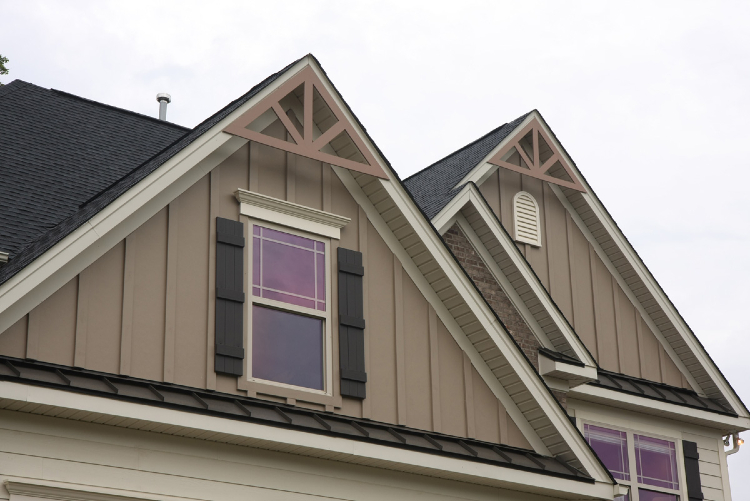
What are the Benefits of Installing Hardie Board and Batten Siding?
Your home, especially after an exterior remodel, should make you happy whenever you see it. With James Hardie siding, you can expect things like top-rated performance, durability, sustainability, lifetime value, and low maintenance, as well as design flexibility. When considering new siding for your home, Hardie board and batten siding is an excellent choice!
At Tevelde and Co., we take pride in offering durable products that provide excellent benefits for hard-working Omaha homeowners.
Unmatched Durability
Board and batten siding was traditionally used with wood, but by using a more modern siding, like James Hardie fiber cement siding, you can achieve an identical aesthetic but with extreme durability!
Your home’s exterior can be exposed to extreme weather conditions. This exposure can lead to trouble, but with James Hardie’s unmatched durability in your exterior siding, you can rest assured your home will be protected all year round.
Low Maintenance Once Installed
With James Hardie Board and Batten siding, it is not only beautiful, but it also provides great home design with low maintenance. Once it is installed, your siding is a very low-maintenance item, providing years of unmatched durability and protection!
Customizable Colors and Style
James Hardie siding can be customized with many different colors and styles to suit every style of home. From historic to modern, let James Hardie siding complete the exterior of your dreams. In addition to multiple styles, the color choices are extensive; create your dream home with customizable color schemes that you will love for years to come!
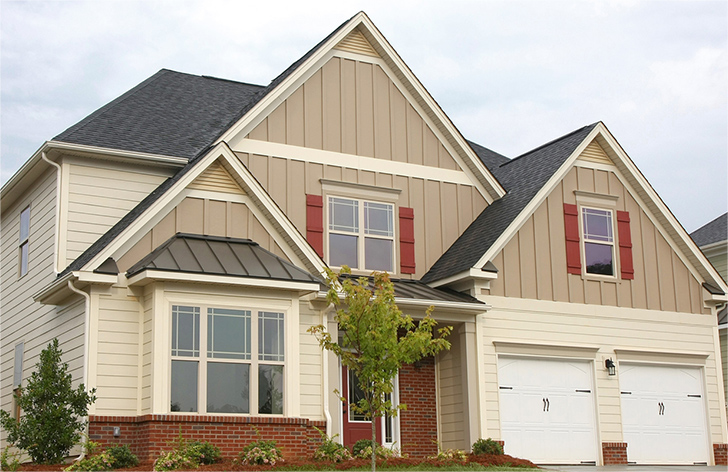
Steps Involved in the Installation Process
James Hardie siding should never be installed as a DIY project. Here are the steps involved that the pros will take when you hire them for your siding installation.
- Remove old siding—Prepare the home exterior for replacement siding.
- Install HardieWrap Weather Barrier—This provides a balance of water resistance and breathability to protect your home from the weather elements.
- Add fasteners—Corrosion resistant, galvanized or stainless steel fasteners are required.
- Install Hardie Board siding—Detailed attention will be given to the joints between siding boards.
- Apply ColorPlus touchup for a finished look—Extra care will be taken not to use too much paint when touching up after installation.
Avoid Installation Problems by Hiring a Qualified Siding Contractor in Omaha
James Hardie fiber cement siding material typically lasts 30-50 years when it’s installed correctly on a home or commercial property. The 30-year warranty is evidence that the manufacturer built this outstanding siding to perform well for decades, giving you confidence in your investment.
Because siding is such a long-term investment, it’s vital you hire an experienced contractor who adheres to the James Hardie protocol for installation. The James Hardie company took the guesswork out of finding a qualified installer by training contractors themselves and then rating them as Preferred contractors or Elite Preferred contractors.
When unqualified or inexperienced contractors install James Hardie siding, problems may occur such as unattractive touch ups. The James Hardie company bakes on color in their controlled factory environment, ensuring it lasts and gives you the best possible look. The problem lies when installation teams apply too much touchup paint (on nails or any slight imperfections on the siding or trim).
If too much paint is applied, it may not be a problem initially, but in time it will fade faster than factory applied paint, and siding may look spotted due to the initial oversaturation of touchup paint. The only remedy for this problem is to repaint the whole home to get even coverage.
When a contractor touches up siding, he should use the right tool for the job to ensure he doesn’t overuse paint. Additionally, the James Hardie company doesn’t allow the use of color matched caulking for touch ups. Caulk weathers at a different pace than siding, so it shouldn’t be used as a touchup.

Tevelde and Co. is a Trusted James Hardie Contractor
Tevelde and Co. works with the highest quality siding to create an excellent home exterior every time. As a trusted and preferred James Hardie contractor, you can expect the best from us and our materials. We also offer a 10-year workmanship warranty on all of our installations! Contact us today to schedule a consultation.
Top-Rated Exterior Services in Omaha
As your trusted Omaha exteriors contractor, we are looking forward to working with you and providing your home with the highest quality products and excellent customer service. We offer free consultations for Nebraska homeowners and bring our top-rated workmanship to every project we take on. Contact us today to start designing and envisioning the exterior you have always dreamed of!

Article Updated: 4/16/24 | Published: 2/3/22
About The Author: Todd Tevelde
Todd Tevelde wrote this helpful article about James Hardie Board and Batten Siding to help educate homeowners about their siding options. Todd is an expert in home exterior renovations and the founder of Tevelde and Co. With over 10 years of experience helping homeowners, Tevelde and Co. has become one of the most trusted contractors in the greater Omaha area. For more information contact Tevelde and Co. today!
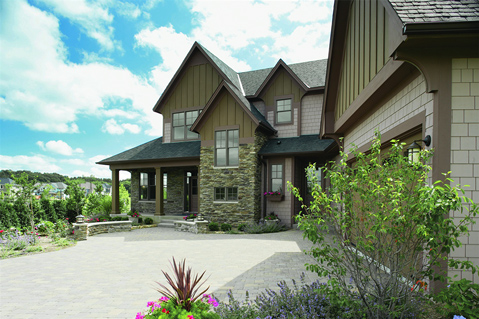
James Hardie Fiber Cement Siding
As the leading fiber cement siding on the market, James Hardie® siding is trusted by homeowners and siding contractors alike for its reliable performance. With its patented technologies that help it withstand any weather and hold in color, Omaha homeowners can rely on James Hardie siding to last for decades while continuing to look beautiful.

Financing Is Available.
Sometimes home remodeling projects can’t wait, or you just want to make all your property updates at once. Get the financing you need with approved credit and check out our special offers to make the most of your home remodeling dollars.


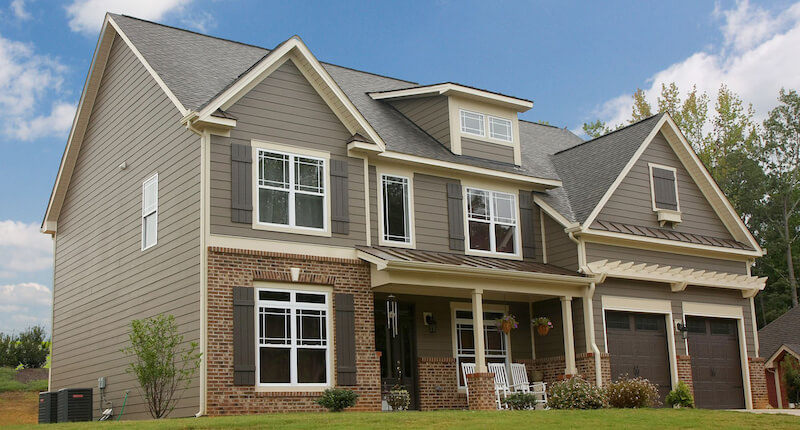
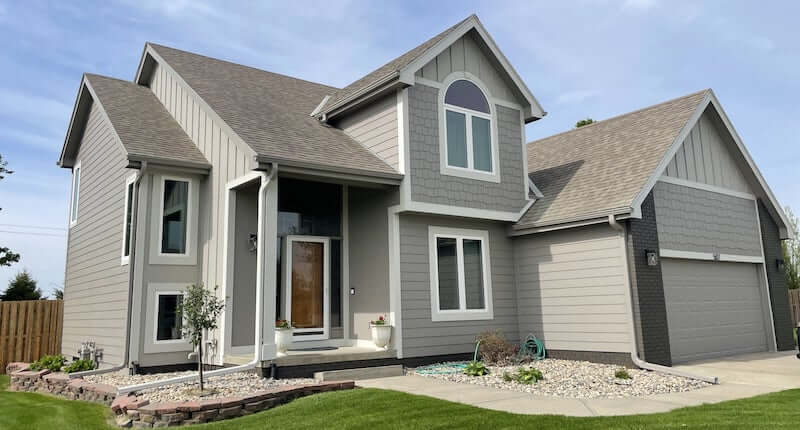 Window Services
Window Services